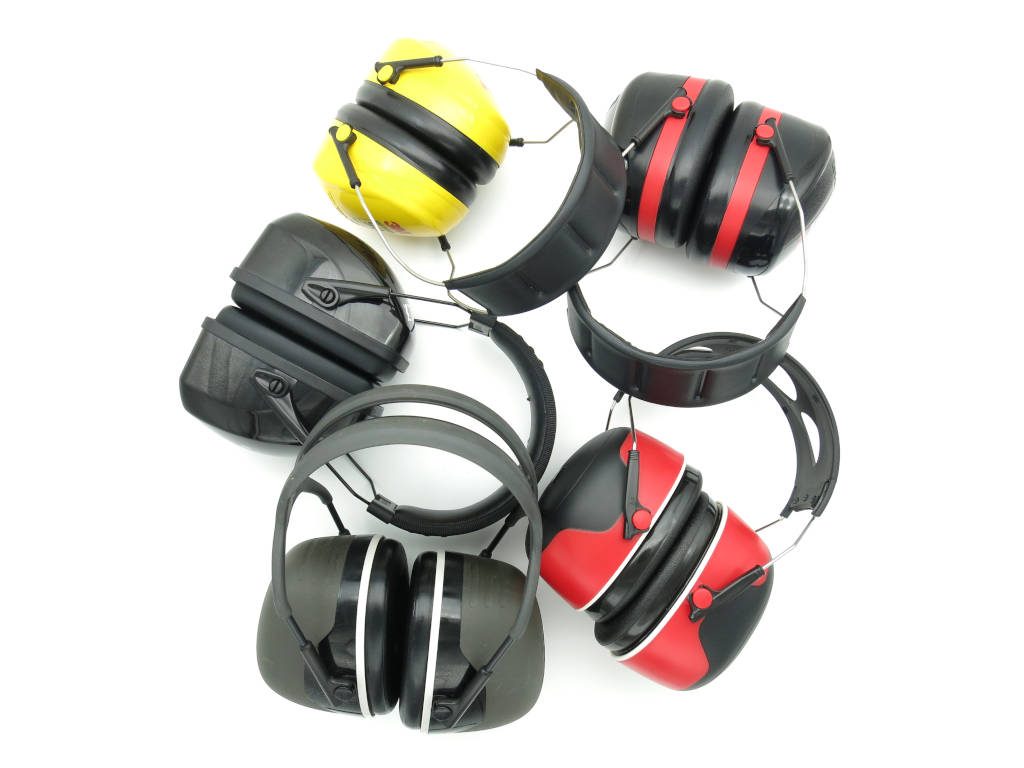 I this post, I am going to review and rank the best noise cancelling earmuffs I have been able to find.
I this post, I am going to review and rank the best noise cancelling earmuffs I have been able to find.
I have owned and used all earmuffs in this review.
I am also going to shed some light on what noise reduction numbers you should insist on when deciding which pair is right for you.
The top 5 muffs in this article are excellent hearing protectors and are being sold as such.
However, students, office workers, and people sensitive to noise are also increasingly using hearing protection earmuffs to reduce the noise and chatter around them so they can concentrate better and eliminate distractions.
I too use earmuffs to improve focus and reduce stress, and I have been astonished what positive difference they can make for productivity and well-being.
It may sound a bit strange but if you live in a big, busy city, you’ll understand the following:
I start most of my city days drinking my morning coffee and meditating while wearing bulky noise blockers.
People suffering from ADHD, misophonia, hyperacusis, increased sensitivity to low-frequency noise, or simply noise fatigue can also benefit from wearing earmuffs and blocking environmental noise.
Terminology:
When talking about noise reduction, noise cancelling, or noise blocking in this post, I am referring to passive noise reduction without using electronics to generate a counter signal to the noise signal.
In contrast, when electronics are being used to generate a counter signal to reduce a noise signal, I will refer to active noise cancelling (ANC) or active noise reduction (ANR).
Almost all hearing protection earmuffs attenuate noise passively. That is what they get their noise reduction rating (NRR) for.
Contents
What you may have read in advertising copy about earmuffs
Chances are you are looking for the highest-rated earmuffs at an economical price.
Perhaps you have read, “Introducing the highest 37 dB NRR ear defenders.”
Or it read “34 dB-the highest rated noise cancelling ear muffs.”
Or perhaps “SNR 36dB Highest Hearing Protection Available.”
But are these headlines actually believable? And are they all talking about the same rating?
What you should know before buying earmuffs
In the U.S, all hearing protection earmuffs have to be labelled with the NRR (Noise Reduction Rating) by federal regulation. This is how such a label looks like on the carton in which the earmuffs are packaged:

If you are buying hearing protection in the U.S., it must have such a label stating clearly the Noise Reduction Rating (NRR), the manufacturer and the model. Even the format of the label is mandated by the EPA!
If you are in the U.S., and your earmuffs don’t come with a label that looks like this, you should be cautious.
The SNR (Single Number Rating, e.g., used in Europe) is not the same as the NRR and generally tends to be a substantially higher number because a different testing and calculation method is being used. For more on this below.
The NRR is a calculated number that is the result of a hearing test called REAT conducted with 10 different test persons according to ANSI standard S 3.19-1974.
Each test subject is exposed to 9 different pink noise signals centered at 9 different test frequencies—one time with and one time without the hearing protector— to assess how effective the worn hearing protector is.
The frequencies are 125, 250, 500, 1000, 2000, 3150, 4000, 6300, and 8000 Hz.
The average attenuation (noise reduction) achieved by these 10 test persons for each frequency, together with the standard deviation is then tabulated and the NRR is calculated.
You can think of the NRR as a kind of weighted average calculated from this table. (There is actually a bunch of logarithms involved, but we don’t have to concern us with the actual calculation here.)
Here is the attenuation table (as found on the box) that resulted in the NRR-30-label shown above:

This attenuation data is supplemental information that has to be provided with the earmuffs as well.
Very often, it is printed on the box, but sometimes you find the attenuation data in an instruction manual or insert inside the box.
If you are buying your earmuffs in the U.S., they should have both the NRR label and the attenuation data when you buy them.
If you are not sure, always ask the company to provide you with this information before buying their earmuffs.
Even If you are “only” looking for earmuffs to help you focus while studying or working in an office, this data can help you to assess how effective your muffs may be at reducing speech and environmental noise.
What is the highest NRR for earmuffs on the market?
The highest-rated commercially available earmuffs I know of have an NRR of 31.
Even this number is rare. More often, you will find an NRR of 30 for the highest-attenuation ear defenders of reputable companies. It is extremely difficult for earmuffs to achieve an NRR of 31.
By comparison, the highest rated earplugs I know of have an NRR of 33. This is because earplugs, when optimally inserted, can achieve a higher noise reduction at the lower frequencies.
So you may wonder, how come some distributors are advertising earmuffs with a noise reduction rating of 34 or even 37 dB?
I would suggest they are not using the NRR in their advertising, but a different number.
They may be referring to the SNR, the Single Number Rating, which is, for example, used in Europe. The SNR is almost always a few decibels higher but it is not the number to be used on the EPA label.
Here are three examples to illustrate the difference between the NRR and the SNR.
| Earmuffs | NRR | SNR |
|---|---|---|
| 3M Peltor X5A | 31 | 37 |
| Howard Leight Leightning L3 | 30 | 34 |
| 3M Peltor X4A | 27 | 33 |
Please don’t compare apples with oranges!
Companies like 3M and Howard Leight (Honeywell), who have been in the business of industrial hearing protection for decades, offer the data for almost all their earmuffs directly on their website.
Overview and ranking of my 5 favorite noise cancelling earmuffs
Before I go into the pros and cons of each individual pair of earmuffs, I want to give you an overview of my 5 favorites and why they are in my best-of-list.
Criteria for comparison and ranking
- Overall noise reduction
- Low-frequency noise reduction
- Speech blocking
- Headband and adjust-ability
- Comfort, including weight, ear pad cushions and opening size
- Durability, including quality and replacement parts availability and sensitiveness to scratches
- Style
1. 3M Peltor X5A, NRR 31 ♦
The Peltor X5A are the most effective earmuffs I know of and the difference to all competitors is clearly noticeable.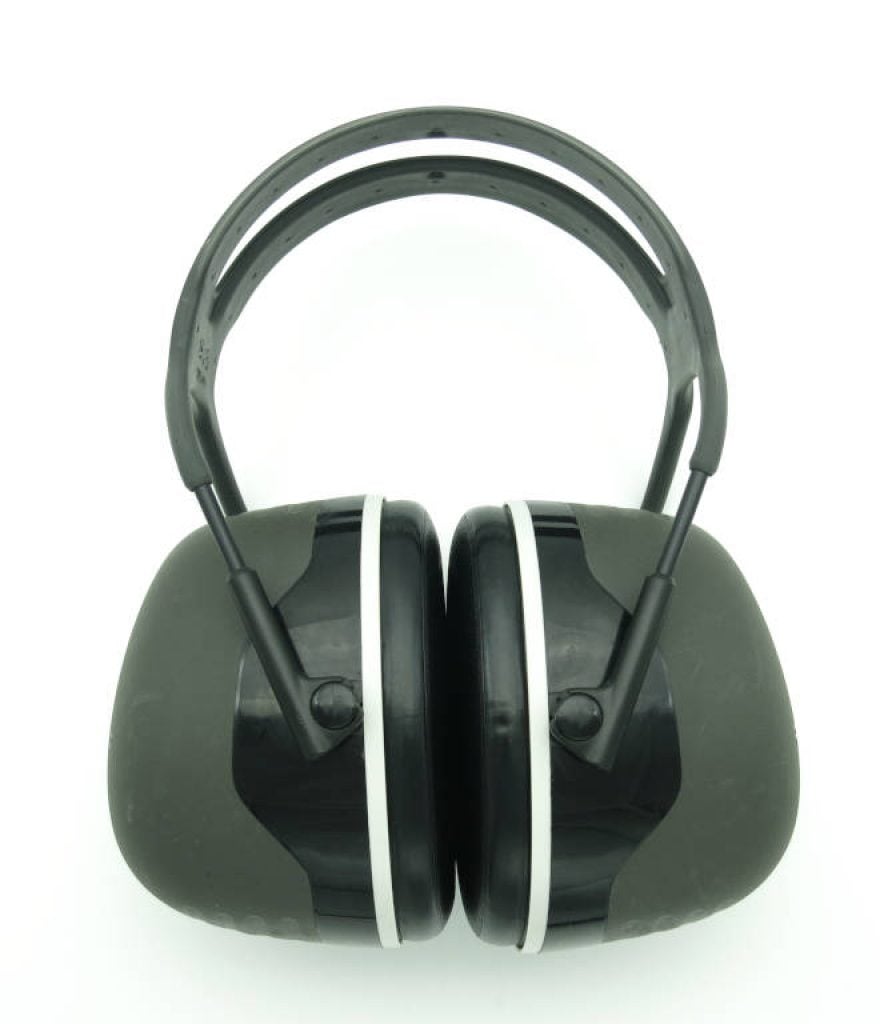
Pros:
- Their noise reduction is exceptional.
- They are extremely well built, comfortable, and fit small as well as large heads.
Cons:
- They have deep ear cups, look big, and are relatively heavy (OK for me).
- The ear cushion openings are on the small side, which can make them uncomfortable for very large ears.
2. 3M Peltor Optime 105, NRR 30
At most frequencies, the Peltor Optime 105 earmuffs are nearly as effective as the X5A.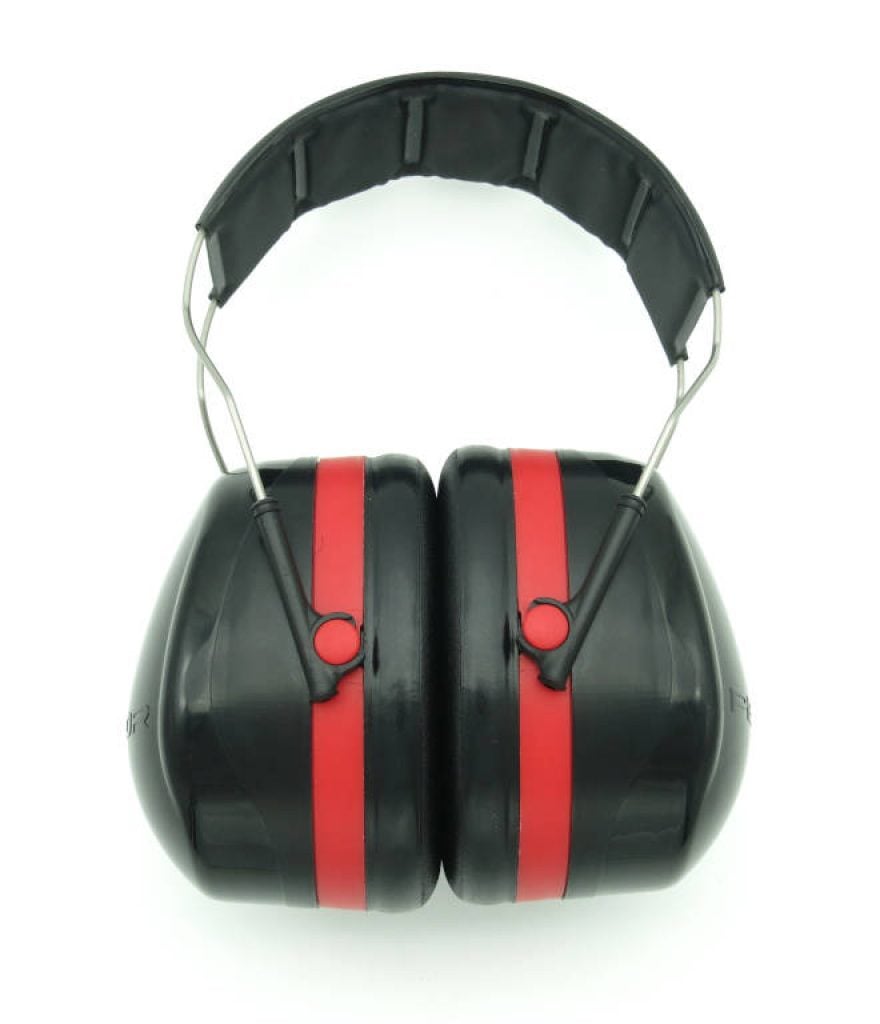
Pros:
- They should fit small as well as large heads and provide ample space for the ears.
- They are lighter than the X5A and have 1 cm shallower ear cups.
Cons:
- In terms of noise reduction, they lag behind X5A in the low and lower-mid frequencies.
- Headband and build quality are good, but not as good as the X5A’s.
3. 3M Peltor Optime 98, NRR 25
The Peltor Optime 98 are the most comfortable earmuffs in this review.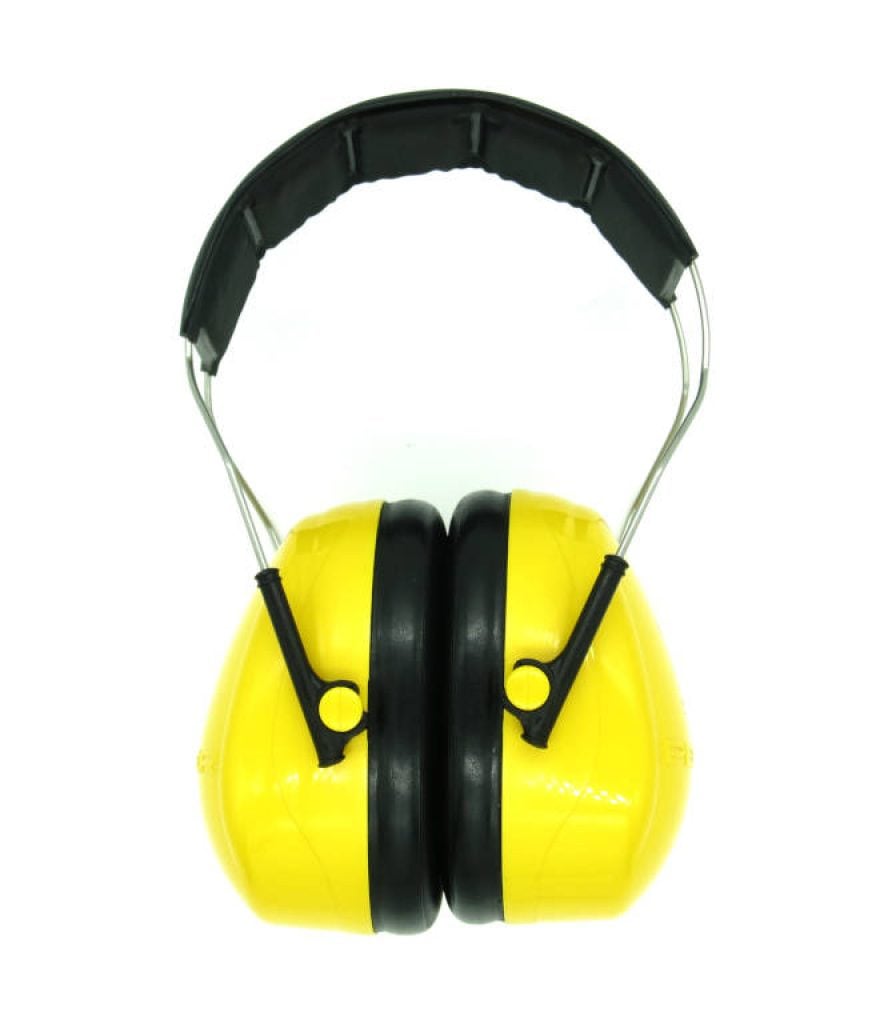
Pros:
- They are very light, should fit small and large heads and provide ample space for the ears.
- They fit adults as well as children and make for good study muffs.
Cons:
- They are NRR-25 earmuffs (recommended by 3M for noise levels of up to 98 dBA) and as such weaker in all frequencies than the top two.
- This “weakness” is most pronounced in the low frequency bands, and least obvious in the higher frequencies.
4. Howard Leight Leightning L3, NRR 30
The Leightning L3 are great at blocking low frequency noise, as good as the X5A (and better than all others).
Pros:
- They attenuate low-frequency noise with less weight and shallower cups than the X5A.
- The ear cushion openings are large with ample space for the ears.
Cons:
- They are comfortable, but much less adjustable than the Peltor earmuffs. They barely fit my medium-large head.
- The earmuffs are well-made, but the soft headband cushion is delicate and prone to damage.
3M Peltor X4A, NRR 27
The Peltor X4A are the most effective low-profile earmuffs I know off. They are noticeably quieter and flatter than the Optime 98.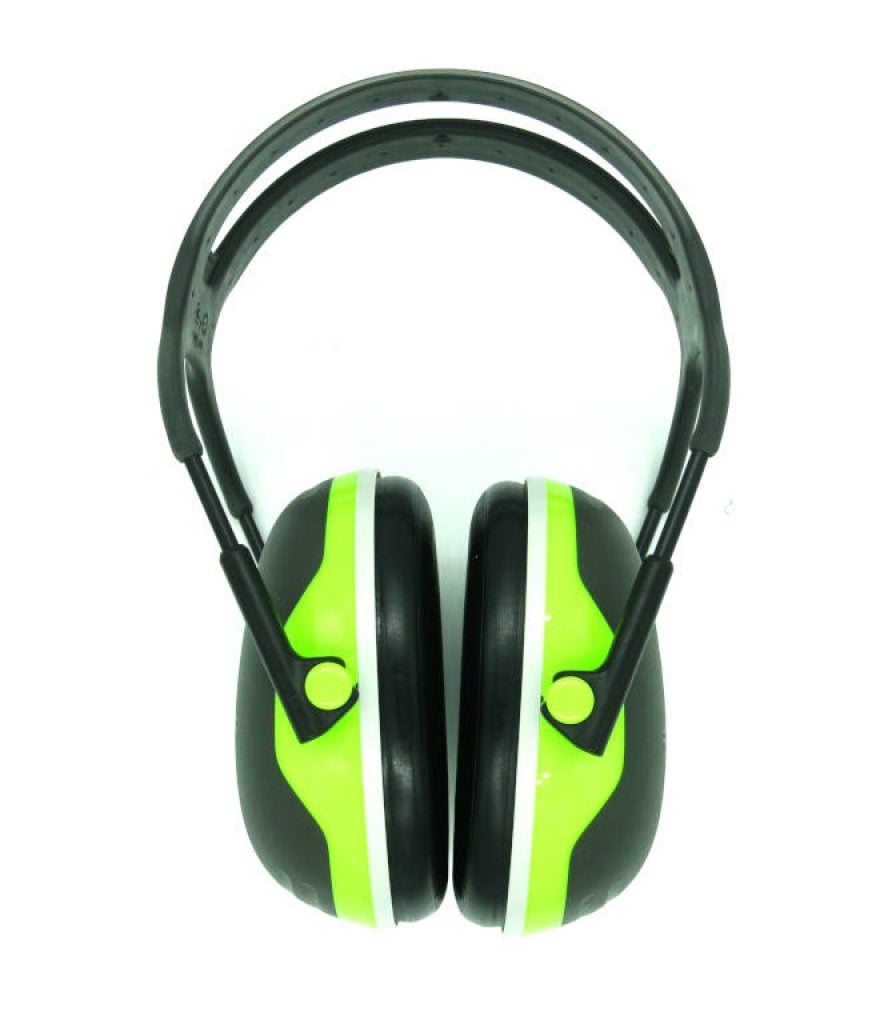
Pros:
- They are light, extremely well-made and they fit small as well as large heads.
- They are good for kids and adults alike and make for good study muffs.
Cons:
- The ear cushion openings are on the small side, which can make them uncomfortable for large ears.
- Because of their low profile they create more of a vacuum feeling when you move or remove the cups.
Noise cancelling earmuffs overall ranking and comparison table
| Rank | Earmuffs | Overall noise red. | Low freq. | Speech | Comfort | Adjust. | Durable | Style | Weight | Cup depth |
|---|---|---|---|---|---|---|---|---|---|---|
| 1 | 3M Peltor X5A | 9 | 8 | 9 | 8 | 8 | 9 | 5 | 350g (12.4oz) | 8 cm |
| 2 | 3M Peltor Optime 105 | 8 | 7 | 9 | 8.5 | 8 | 8 | 6 | 286g (10.1oz) | 7.2 cm |
| 3 | 3M Peltor Optime 98 | 7 | 6 | 8 | 9 | 8 | 8 | 7 | 222g (7.8oz) | 6 cm |
| 4 | Howard Leight Leighting L3 | 8 | 8 | 8 | 8.5 | 6 | 7 | 7 | 300g (10.6oz) | 7.4 cm |
| 5 | 3M Peltor X4A | 7 | 6.5 | 8 | 7.5 | 8 | 9 | 8 | 230g (8.1oz) | 4.5 cm |
Noise reduction by frequency
| Earmuffs | NRR | 125 Hz | 250 Hz | 500 Hz | 1000 HZ | 2000 Hz | 3150 Hz | 4000 Hz | 6300 Hz | 8000 Hz |
|---|---|---|---|---|---|---|---|---|---|---|
| 3M Peltor X5A | 31 | 23.9 | 30.5 | 41.1 | 43 | 38 | 43.1 | 44 | 41.1 | 40.3 |
| 3M Pro-Grade | 30 | 23.1 | 26.1 | 36.5 | 41.5 | 40.4 | 41.8 | 42.3 | 42.5 | 41.4 |
| 3M Peltor Optime 105 | 30 | 21 | 26 | 36.6 | 40.6 | 38 | 41.8 | 42.7 | 41.7 | 41.3 |
| Howard Leight, Leightning L3 | 30 | 23.8 | 28.8 | 36.5 | 39.9 | 35.3 | 38.7 | 39 | 41 | 40.8 |
| 3M Peltor X4A | 27 | 20.5 | 24.1 | 32.8 | 40.7 | 37.6 | 44.5 | 45.4 | 42.4 | 42.3 |
| 3M Peltor Optime 98 | 25 | 15.5 | 22 | 33.7 | 39.7 | 36.5 | 42.7 | 40.1 | 39.8 | 40.6 |
The best low-frequency noise reduction earmuffs
With low-frequency noise, I am referring to noise <= 500 Hz.
A busy city road with rumbling trucks, cars, and motorbikes contains large amounts of low-frequency noise. Perhaps you are like me, and find this kind of noise irritating and stressful.
Industrial examples include diesel generators and locomotives, compressors, chillers, and boilers.
At home, AC-compressors, refrigerators and washers also emit low-frequency noise.
My favorite earmuffs for blocking low-frequency noise are the Peltor X5A and the Leightning L3.
Here then is my low-frequency noise reduction ranking
| Rank | Earmuffs | Rating (out of 10) |
|---|---|---|
| 1 | Peltor X5A & Leightning L3 | 8 |
| 2 | 3M Pro-Grade & Peltor Optime 105 | 7 |
| 3 | Peltor X4A & Optime 98 | 6 |
How to improve on the low-frequency attenuation of earmuffs?
In principle, earplugs could be better at reducing low-frequency noise.
To achieve that better noise reduction, you have to insert them very deep into the bony part of the ear canal. Partial insertion can lead to a loss of 20 dB or more in low-frequency attenuation. That is like a quadrupling of the noise level.
Many people don’t achieve the benefits earplugs could provide at lower frequencies because they only insert their earplugs partially or cannot tolerate deeply inserted earplugs for long periods of time.
Doubling up:
For better protection against low-frequency noise, “doubling-up,” that is, wearing earplugs and earmuffs on top of them can be highly beneficial.
Be aware though that you cannot just add the noise reduction of the earmuffs and earplugs. How much you can gain depends very much on the frequency. Still, in particular for the low and low-mid frequencies up to 1000 Hz, the gains you can achieve by wearing optimally inserted earplugs underneath your muffs can be substantial.
OSHA adds 5 dB to the protector with the higher NRR when estimating the total noise reduction. See this post for more information on estimating the noise reduction when wearing double protection.
The best noise cancelling earmuffs for blocking out speech and studying
If you want to wear earmuffs to improve your ability to focus on studying, reading or writing, you have to choose a pair that effectively blocks out people talking around you.
The frequency range from 500 to 4000 Hz is the most important for speech intelligibility.
In general, I find that all earmuffs in this review are quite good at reducing the chatter around me. If the “offenders” are at a distance of a few meters, I am reasonably satisfied with either one of them.
On the other hand, if a person sitting only a meter away from me holds a loud phone conversation or raises their voice, none of the muffs will completely mute that.
As I see it, the best earmuffs get pretty close to what is possible for speech blocking before sound transmitted through the skull becomes dominant.
Here then is my ranking for the best voice blocking and studying earmuffs:
| Rank | Earmuffs | Rating (out of 10) |
|---|---|---|
| 1 | Peltor X5A | 9 |
| 2 | 3M Pro-Grade & Peltor Optime 105 | 9 |
| 3 | Peltor X4A, Leightning L3, Optime 98 | 8 |
How to improve on the speech blocking ability of earmuffs?
I get a slight boost by adding earplugs underneath, but bone conducted sound cannot be cancelled with earmuffs, earplugs or active noise cancelling headphones.
To improve significantly on the performance of the earmuff-earplug combination for blocking speech, you would need a noise cancelling helmet covering the whole head.
You can, however, eliminate the distracting nature of human speech by masking it with white noise. For this you could either wear earbuds underneath your earmuffs or use a flat speaker insert which I find more comfortable.
For more on how to use earmuffs together with noise masking, check my post Creating Effective Speech Noise Blockers for Office and Studying.
Hearing protection earmuffs with Bluetooth
All safety earmuffs reviewed in this post are passive earmuffs without built-in speakers.
They are optimized for reducing noise. The highest rated ones in this post are more effective than any electronic earmuffs I am aware of.
However, tf you are looking to protect your hearing on the job while listening to music or taking phone calls, Bluetooth earmuffs can do that.
If that interests you, read my comprehensive test and review of Bluetooth hearing protection earmuffs.
They typically have an NRR of 24 to 25, so lower than the highest rated earmuffs in this review, but they are very popular for landscaping, lawn-mowing, woodworking, etc.
Detailed reviews of all earmuffs
All earmuffs reviewed in this post
- 3M Peltor X5A, NRR 31
- 3M Pro-Grade, NRR 30
- 3M Peltor Optime 105, NRR 30
- Howard Leight Leightning L3, NRR 30
- Mpow [Upgraded] Noise Reduction Safety Ear Muffs, NRR 29
- 3M Peltor X4A, NRR 27
- 3M Peltor Optime 98, NRR 25
3M Peltor X5A earmuffs, NRR 31 detailed review
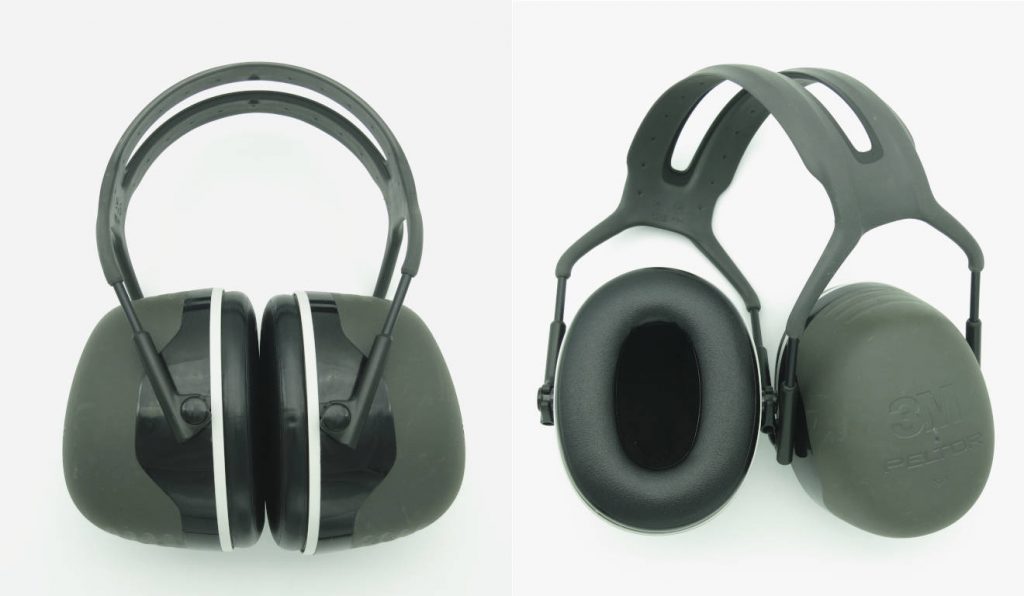
The 3M Peltor X5A are the most effective noise reduction earmuffs I know of. They are the only NRR-31 earmuffs I have been able to locate.
Their noise reduction is impressive across the whole frequency range. For low-frequency noise they are on par with the Howard Leight Lightning L3, but surpass them in nearly all other octave bands.
Slightly ahead of the 3M Pro-Grade and 3M Peltor Optime 105, they are also the best speech blockers in this review.
Headband
In my opinion, the X-series earmuffs have the best-designed and most durable headband of all muffs in this review.
The X5A, as other models in the 3M X-series, have a rubbery-plastic-coated metal-wire headband. Unlike many other headbands, the top is open, so there is nearly no heat build-up. According to 3M, the headband is electrically insulated for low-voltage electrical hazards (less than 440 volts AC).
The headband is adjustable to fit a large range of head sizes. It conforms perfectly to my head, and I don’t feel any pressure points. With 350 grams, the X5A are relatively heavy earmuffs, but the headband and cups don’t slide down.
I have used these earmuffs almost daily now for 2.5 years, and the headband is as good as new.
Comfort
I wear the X5A for three hours without problems, so they are comfortable for me.
They have an unusual ear cushion design whereby the inner ring of the ear cushion opening (the spacer opening) is relatively small, but the ear actually goes behind that ring where there is enough space.
At first, I put them on just like I would put on headphones, with the result that the ear cushions would partially rest on my ears, making them uncomfortable after a while.
The way I put them on now and that works very well: I slide the ear cups over the ears from behind. That way, the cushions fit around the ears and the ears have enough space inside the cups. Then I adjust the headband for optimal comfort and weight distribution.
The X5A weigh 350 grams, which makes them heavier than all other muffs except for the 3M Pro-Grade (370 grams). I guess this is the price for their great noise isolation. Given the great headband, the weight is fine with me.
If you do a lot of overheard work though, the weight might bother you.
Comparing the X5A to other NRR-30 earmuffs, I find the lighter 3M Peltor Optime 105 slighty more comfortable to wear, but both earmuffs work for me.
The most comfortable earmuffs are the NRR-25 rated 3M Peltor Optime 98.
Cup size and Design
The cups of these muffs are about 8 cm deep, the deepest of all earmuffs.
There is no mistaking them for headphones. Wearing them, you will look like an airfield mechanic.
On the other hand, if you use them in an office or while studying, the people around you will know clearly that you don’t want to be disturbed.
Over time, I have found that these large ear cups also provide another unique advantage:
With my ears covered by them, the noise reduction seems to be even better than it is on paper.
At times, I feel like I am in an “almost soundproof room.” It is hard to explain but I like how this feels. Because of this they make for great muffs for meditation.
But because they are large, depending on your technique and the rifle, they may or may not work well for rifle shooting.
Quality, Durability and Maintenance
The Peltor X5A are extremely well-built and durable. The matte cups have a softer plastic covering, so you won’t see scratches easily. The headband is made of steel metal wires, coated with a rubbery plastic; after more than two years of use, it is as new.
After prolonged use, the ear cushions of any earmuffs will wear out and the insulation foam inside the cups can get dirty or deteriorate.
Both the ear cushions and the insulation foam are user-replaceable and readily available for purchase in a hygiene kit.
A sturdy case is also available for these earmuffs to prolong their life and keep the dirt out.
These muffs should last for a long time.
3M Peltor Optime 105 earmuffs, NRR 30 detailed review
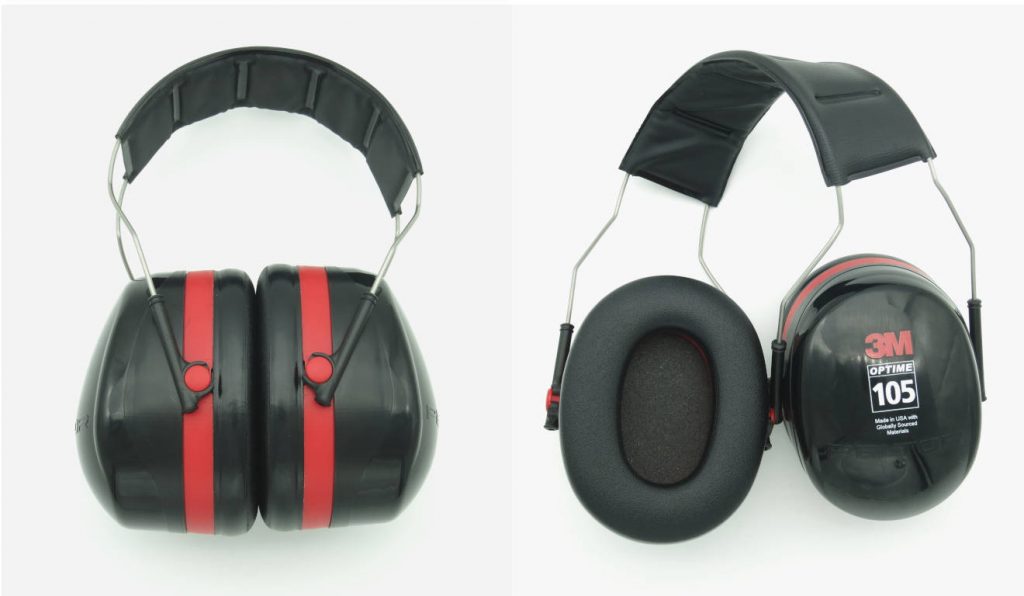
The Optime 105 are great NRR-30 noise reduction earmuffs. They are not quite as effective as the X5A, lagging behind slightly in the low-and-mid frequencies. Overall, the difference is not large, but it is clearly noticeable.
On the plus side, their cups are 0.8 cm shallower than the X5A’s, weighing 286 grams they are lighter than the X5A (350g), and they have larger cushion openings for the ears.
They are also slightly easier to put on than the X5A and a tad more comfortable, especially if you have large ears.
The Optime 105 are amongst the best earmuffs for blocking speech, almost as good as the X5A and significantly better than the NRR-30 Howard Leight Leightning L3.
Headband
The Peltor Optime 105 earmuffs share the same headband design with the Optime 98 and the rest of the Optime series.
It is made out of stainless steel wires with a plastic cushion on the top. It is as adjustable as the X-series headband and conforms to the head. I find it almost as comfortable but it isn’t quite as ventilated.
I can wear a baseball cap on top of these earmuffs, more so than with the X-series band.
Unlike the X-series headband, the Optime-series band is not electrically insulated, so if you need that, you can’t get these earmuffs.
Overall, the X-series headband is better. It has an opening at the top to prevent heat built-up and it is almost indestructible. It also looks more premium.
Cup size and Design
The cups of these muffs are 7.2 cm deep, noticeably shallower and lighter than the X5A cups (8 cm).
The X5A achieve their noise reduction with a single-cup design. These have a twin-cup design, with an outer and an inner shell separated by foam.
The Optime 105 look a little more understated than the X5A, but most people will clearly recognize them as earmuffs.
The cups are built out of hard-plastic; there is no soft rubber coating as with the X5A.
Still they feel very solid and it would take quite some effort to damage them.
Overall, I prefer the cups of the X5A though. I like the feeling that comes with their spaciousness.
But, if you want to use the Optime 105 for rifle shooting, their somewhat shallower design may be an advantage.
Quality, Durability and Maintenance
The Optime 105 are well-built and durable. The cups are made of hard plastic and the headband consists of steel wires with a plastic cushion on top.
After prolonged use, the ear cushions of any earmuffs will wear out and the foam inside the cups can get dirty or deteriorate.
The ear cushions and the insulation foam inserts are user-replaceable and available for purchase in a hygiene kit.
A case for the Optime 105 is also available to prolong their life and keep them clean.
Howard Leight Leightning L3 earmuffs, NRR 30 detailed review

The Leightning L3 are a solid pair of earmuffs with great low-frequency noise reduction at a moderate weight (300 g). The low-frequency reduction is as good as the substantially heavier 3M Peltor X5A earmuffs’ and better than the Optime 105 and the 3M Pro-Grade.
So if you are looking for lighter earmuffs to block generator noise, rumbling, or other low-frequency machine noise, the L3 are a great choice.
For high-frequency noise and speech blocking both the X5A and the Optime 105 are better than the Leigthning L3.
I find the L3 comfortable; the ear cups have an opening that provides enough space for larger ears. They are easy to put on and take off.
The ear cushions are made of a relatively stiff plastic. This doesn’t bother me per se, however, when I sweat, the ear cushions become slippery and the muffs slide around.
The ear cups are solid; you would have a hard time breaking them.
Headband
The headband of the L3 is made of steel wires and padded with a soft material, which is comfortable but a bit delicate. I managed to damage it in several places just by being a bit careless with my nails.
These earmuffs fit my head but only just. I have to pull the headband out to its maximum extension, and my head is average-size. If you have a large head, these may not fit.
Overall the L3 are much less adjustable than both Peltor X-series and the Optime-series earmuffs.
Cup Size and Design
The cups are 7.4 cm deep, about as deep as the Optime 105’s cups.
Like most earmuffs, the Leightning L3 use a single-shell cup design. The way they are designed, the great low-frequency noise attenuation is surprising. Howard Leight state that this is due to their patented air flow control technology.
Whatever that technology may do, the muffs work really well.
Of all high-attenuation (NRR-30) earmuffs I know of, these look the most like regular headphones; I wouldn’t feel out of place wearing them in an office, a coffee shop, or a library.
Quality, Durability and Maintenance
The built-quality is fine. The main weakness of these muffs is the headband padding. Sharp or pointed objects can easily damage it.
Exposed to heat and sweat, the ear cushions of all muffs deteriorate over time. A hygiene kit is available for the Leightning L3, so you can swap out the ear cushions and insulation foam. This is a great way to prolong the life of the earmuffs.
3M Peltor X4A, NRR 27 earmuffs detailed review
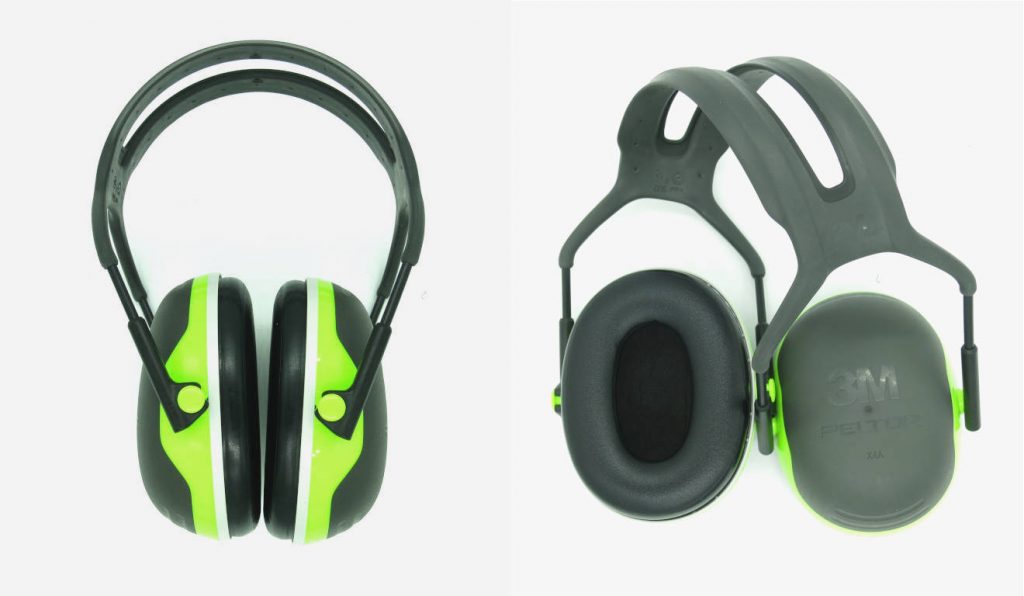
The Peltor X4A are the highest rated low-profile earmuffs I have found. Including the ear cushions, the cups are only 4.5 cm deep, so a bit more than half the cup-depth of the X5A and still about 1.5 cm less than the Optime 98.
At 230 grams, they are also among the lightest earmuffs.
The X4A have the same headband (my favorite headband) as the X5A, well-made, comfortable, virtually no heat build-up, and adjustable to fit small as well as large heads.
They also share the same ear cushions and the same spacers (the grey rings that connect the cushions with the cups) with the X5A.
I believe this cushion-spacer combination is the reason why the X4A are such effective earmuffs.
But, on the flip side, compared to other muffs the opening for the ear is relatively small, so if you have very large ears you may find the opening too small for comfort.
In addition, because the cups of the X4A are low-profile (and hence have less volume), these muffs can create a bit of a suction feeling when you move the cups around or take the muffs off. For comparison, with the X5A, due to their large-volume cups, I don’t get this feeling at all.
Compared to their nearest competitor, the Optime 98, the X4A are a slightly more effective at reducing noise and that at virtually all frequencies. In particular at the lower frequencies, this difference is noticeable.
On the flip side, I find them less comfortable than the Optime 98 (but not uncomfortable).
If you need high-attenuation low-profile earmuffs, these are a great choice.
In terms of looks, the X4A are among my favorite earmuffs. They are slim and look sleek.
Quality, Durability and Maintenance
The 3M Peltor X4A share the same excellent build-quality with the X5A. The matte cups are coated with a soft plastic and the headband is made of steel-wires and embedded in a soft rubbery plastic. You will have a hard time damaging these.
Like for the X5A a hygiene set containing the ear cushions and the insulation foam is available, so you don’t have to replace the whole muffs when the cushions are worn out.
3M Peltor Optime 98, NRR 25 detailed review
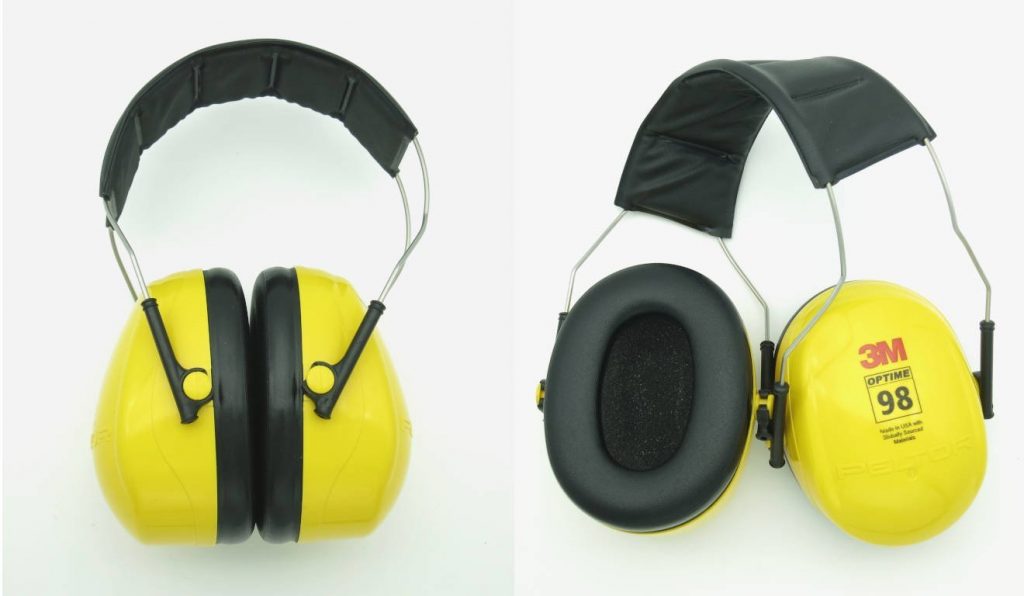
The Peltor Optime 98 are the lightest (222g) earmuffs in this review.
I find them also the most comfortable ones.
The ear cushion opening is as large as the Optime 105’s and should fit even large ears. The headband is the same as the Optime 105’s and adjustable for small as well as large heads. So these should fit kids as well as oversized hulks.
In terms of overall noise reduction, the Optime 98 are the weakest in this review, mainly because of their comparatively weak low-frequency noise attenuation.
But keep in mind that these are designed to be NRR-25 earmuffs and advertised as such. 3M recommends them for noise levels of up to 98 dBA.
Most other earmuffs in this review are NRR 30, designed to get close to the limits of what passive earmuffs can achieve.
These muffs are great to protect hearing in a medium-noise environment and as a light-weight everyday-noise and speech blocker.
The most important frequency bands for understanding speech are from 500 to 4000 Hz.
If you look at the comparison chart, in this range, the NRR-25 Optime 98 perform as well as the NRR-30 Leightning L3. And, this is also the subjective feeling I get wearing them.
As described in the post Creating Effective Speech Blockers for Office and Studying on a Shoestring, you can optionally combine them (as well as the other muffs in this review) with flat speakers and add a masking noise if you are as bothered by heated conversations as I am.
They make for great budget study earmuffs. Because they are so light and adjustable, they are also suitable for smaller children.
If you or your loved-ones can’t focus due to ADHD or misophonia, these are a good alternative to earplugs.
Cup Size and Design
The cups of the Optime 98 are about 6 cm deep (including the cushion), shallower than the cups of all other earmuffs in this review except for the 3M Peltor X4A.
The cups are made of a durable hard-plastic and come in a signaling-yellow.
Despite them being relatively low-profile, if you wear them in an office, the color will give them away as safety earmuffs, if you are concerned about this.
On the other hand, the yellow ear cups might make it easier to find your child.
Quality, Durability and Maintenance
The Optime 98 have the same steel-wire headband as the Optime 105 and the cups are made of a durable hard-plastic.
Short of a manufacturing fault or someone trying to break them on purpose, they should last a long time.
3M offers replacement ear cushions and foam inserts for the Optime 98, but so far I have only seen them in packs of 20 kits, so this may be OK if you are getting these muffs for your whole team.
3M Pro-Grade, NRR 30 detailed review
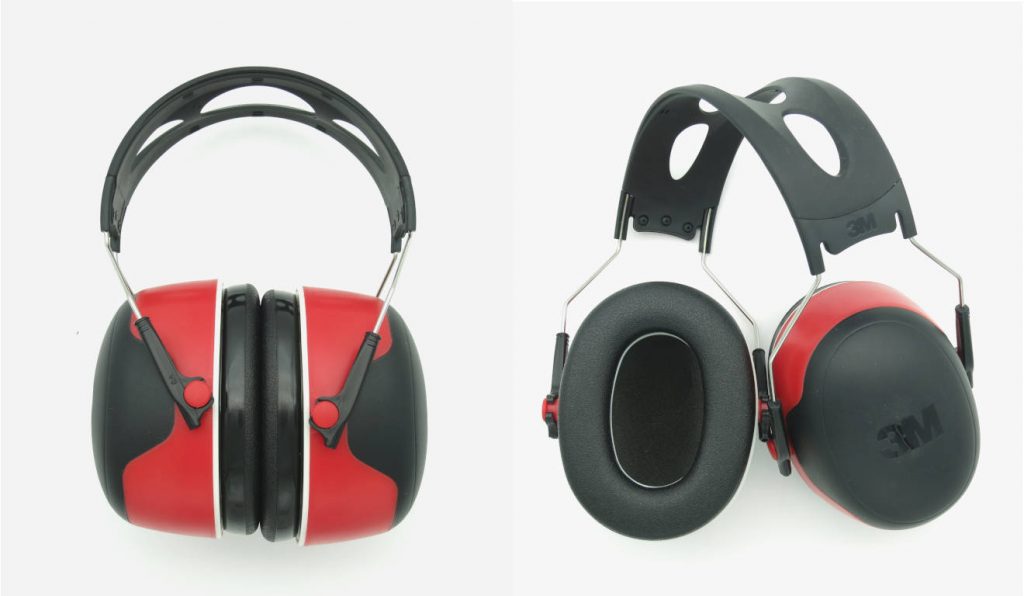
The Pro-Grade earmuffs are one of the newest earmuff models released by 3M. When they came out, I was really excited. Their noise attenuation is great.
In terms of overall noise-reduction they are a tiny bit better than the Optime 105, but it is more or less the same.
After using them for a while though, I have come to the conclusion that the Peltor X5A still attenuate noise better than the Pro-Grade.
In particular in the range from 250 to 1000 Hz the X5A are noticeably better. Mind you, no other muffs I have reviewed come close to the X5A in this range.
In terms of low-frequency attenuation, the Pro-Grade are on par with the Optime 105, but still not as good as the X5A or the Howard Leight Leightning L3.
They match the Optime 105 when it comes to blocking speech, almost as good as the X5A
The main advantage of these muffs is that the ear cushion opening is significantly larger than the X5A’s and even slightly larger than the Optime 105’s.
What’s more, the cushions themselves are very soft and comfortable. So in terms of cup openings and cushions these are great.
The headband is as adjustable as the X-series and the Optime-series headbands, so the muffs fit smaller as well as larger heads.
Unfortunately, the Pro-Grade, weighing nearly 370 grams, are much heavier than the Optime 105 by the same manufacturer; they are even heavier than the already heavy X5A; we are getting close to 1 pound.
I don’t know why 3M advertises them as light-weight, because light-weight they are not!
I am still OK with the weight, but wearing them, the headband de-adjusts itself, and the cups slowly slide down. This makes them difficult to use.
Cup Size and Design
The cups are 7 cm deep, in line with the Optime 105 and Leightning L3, and by about 1 cm shallower than the X5A’s cups.
Like most muffs in this review, these feature a single-shell cup design. The cups are thick, solid, and the heaviest of all muffs in this review.
The 3M Pro-Grade are clearly recognizable as earmuffs, but they don’t look as huge as the X5A.
Quality, Durability and Maintenance
The built-quality of the cups is fine. The headband-is made out of steel-wires with over-molded rubber on the top. The rubber-top has large openings, so the headband is well ventilated.
The main weakness seems to be the adjustment mechanism of the headband or the fact that the cups are so heavy.
When I wear the Pro-Grade, the ear cups just won’t stay in place.
For comparison, I have tried the X-series headband together with these cups: with that headband, they stay in place.
Unfortunately, these muffs aren’t certified with the better X-series headband, so you can’t swap out the headband to use them as a hearing protector.
But if you are looking for high-attenuation study or open-office muffs for big ears, getting the cheapest X-series model for the headband and this model for the cups might be an option.
I haven’t been able to locate a hygiene kit to replace the cushions and foam lining of these earmuffs, so you will likely have to buy new muffs when the cushions are spent.
Mpow [Upgraded] Noise Reduction Safety Ear Muffs, NRR 29 detailed review
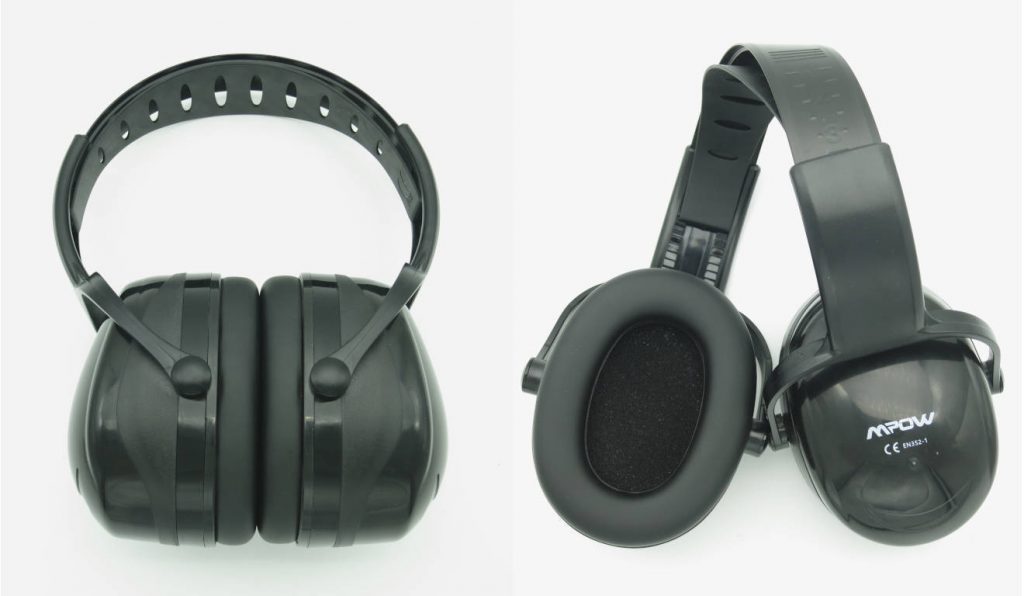
Recently, earmuffs under the Mpow brand have become quite popular, and I wondered how they compare, so I ordered a pair of the Mpow upgraded noise reduction safety earmuffs.
Mpow states that they have an NRR of 29 (SNR 36). These numbers are printed on the box I received.
Unfortunately, there is no EPA label on the box (and none in the box either). Since this label is mandatory for hearing protection in the U.S., I wouldn’t dare to use them where hearing protection is required.
There was also no detailed attenuation data for the different frequency bands, neither on the box nor in an insert. (See the beginning of this post for how the label and the attenuation chart look like.)
Upon contacting the distributer, they weren’t able to provide me with the attenuation data on which the NRR is based.
Note that in contrast, this information is available for all other earmuffs in this review.
So for the time being, I will also not consider using them as safety earmuffs when working in a high noise environment in a private setting.
I can only review these as study and open office earmuffs where the challenge is to block distracting noises rather than protect hearing.
The earmuffs are relatively light (280 g). They weigh about the same as the 3M Peltor Optime 105.
The cushions have large openings for the ears, so they should also fit large ears.
The headband is made out of plastic and adjustable, but much less so than the headbands for the 3M earmuffs. I have to extend the headband to the max to put on these earmuffs, and the lower end of the cups still sits on my ears. If you have a large head these might not fit.
By comparison, the Optime headband is a lot more adjustable and fits small as well as large heads.
On the plus-side, I like the large cushion openings. If your head is small enough they would perhaps be as comfortable as the 3M Peltor Optime 105.
I tried the Mpow muffs with different distracting noise sources and also as a speech blocker (basically what you would get in an open office or café) and they perform well, but regardless of the noise I find them less effective than the Optime 105.
I use the 3M Peltor Optime 105 as a reference here because the physical characteristics of the Mpow and the Optime earmuffs are very similar (size, cup depth, and weight).
Cup Size and Design
The cups of these earmuffs are about 7 cm deep and the muffs weigh about 280g, both on par with the Optime 105.
The Mpow muffs have a twin-cup design, with an outer and an inner shell separated by foam.
These are not small earmuffs, but because they are completely held in black, they look more like headphones than the 3M Optime 105. I would not mind wearing these in an office or a coffee shop.
Quality, Durability and Maintenance
The cups are hard-plastic. The headband is made out of plastic and has plastic hinges. I am a bit concerned about its durability, but I would be OK with it, provided it was more adjustable.
I haven’t been able to find replacement cushions and foam inserts for these earmuffs. You will likely have to buy new muffs when the cushions are spent.
Conclusion
In this review, I have looked at seven different noise cancelling earmuffs and ranked my top 5. In my opinion all of the top 5 are good earmuffs. Each pair is optimal for a slightly different use case. Are you still wondering which ones to get?
So which ones should you get?
If you need high-attenuation earmuffs, get the 3M Peltor X5A (the best) or the 3M Peltor Optime 105 (larger ear cushion openings and lighter). Both are great muffs and I find both of them comfortable.
I like the X5A for their outstanding noise reduction and I keep coming back to them.
The Optime 105 are almost as good as the X5A, but lag behind them in the range from 250 to 1000 Hz. The difference becomes obvious when being exposed to traffic or generator noise, that is, low and low-mid frequency noise.
The Optime 105 have larger ear cushion openings than the X5A, so if you have very large ears they may be more comfortable. They also have slightly shallower cups (7.2 cm vs 8 cm).
In addition to one of them, I suggest getting a pair of the Peltor Optime 98. They are very light and comfortable and also fit children. They are great for reducing environmental noise and make for nearly as effective speech blockers as the first two.
If you need effective low-profile earmuffs, try the Peltor X4A. They are also light and should fit adults as well as children, but have smaller cup openings than the Optime 98.
Notes:
Noise reduction ratings and attenuation data as per earmuff packaging and insert.
EPA label and attenuation chart images taken from the package of the 3M Optime 105 (H10A) earmuffs.
The earmuffs depicted in the images are in use; some scratches and scuff marks may be visible.


![Active Noise Cancelling vs Noise Isolating Headphones [Tested] Active Noise Cancelling vs Noise Isolating Headphones [Tested]](https://cdn.noisyworld.org/wp-content/uploads/2021/09/noise-cancelling-vs-noise-isolating-headphones-200x130.jpg)
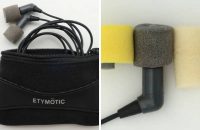
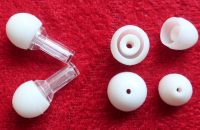
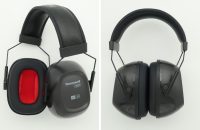
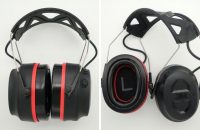
Think how quiet submarines are. They have to be. This is life and death for submariners. The Kriegsmarine started covering the hulls of type 7s in rubber. This is now standard on all submarines. I recently modded my current sound reduction earmuffs by covering the external shell with rubber strips cut from a wheelbarrow tire. Then I used the remaining rubber scraps alternating with felt inside the shell. This greatly reduced low frequency noise.
Hello John,
Thank you very much for this interesting excursion and sharing the improvements you have made to your earmuffs.
Interesting enough, the 3M X-series muffs have cups with a rubberized exterior and also feature a rubberized headband.
Also, the 3M Pro-Grade earmuffs have a few strips (they look like made of carbon fiber) attached to the inside of the ear cups, likely to modify their acoustic properties.
I would like to add a few things for your consideration:
By adding rubber strips to your cups, you are obviously changing their acoustic properties. For a certain frequency range this works for you, but it could possibly reduce their effectiveness at other frequencies. (Ideally, you would need to retest your muffs at all octave band center frequencies.)
What kind of noise did you use to compare their attenuation before and after?
A very effective way to improve on the low-frequency attenuation of earmuffs is to wear foam earplugs underneath. With deeply inserted earplugs you can get pretty close to the maximum low-frequency attenuation possible. (Beyond a certain point, bone conducted sound becomes dominant.)
All the best.
Hello Helmut,
Would wearing earplugs under earmuffs be effecive at attenuating high-frequecy sounds as well?
Thanks,
Felicien
Hello Felicien,
Yes, compared to the earmuffs’ attenuation, doubling up with earplugs underneath will generally also help for the frequency bands from 3150 to 8000 Hz.
At around 2000 Hz, the limits imposed by bone conduction are the lowest, so in many foam earplug-earmuff combinations the improvements, if any, are the smallest.
Have a great day.
Hi, thanks for this fantastic article.
Noise is a real issue for the average person too and I don’t see too many people / articles addressing this.
Just wondering if you’d have a similar list for earmuffs that also double up as headphones.
Thanks again!
Hi Prem,
Thank you for your feedback.
I have tested a few noise protection earmuffs with built-in headphones.
Please check out my review of the 3M Worktunes Connect for their noise reducing performance and sound quality.
I like them, and in terms of their performance, they are a good alternative to the NRR-25 Optime 98.
So far I haven’t been able to locate any NRR-30 earmuffs with built-in speakers that I find convincing as an audio listening device.
All the best.
Hello Prem,
What a great article.
Among the Peltor products, can you help me? As a senior reading a book outside, there are teenagers and pool parties behind our home, and small children and a baby with an occasional barking German Shepherd beside us.
I really would like to shut out as much noise as possible. Any recommendations?
Thank you so much.
Hello Ron,
I assume you don’t want to play any sound through your earmuffs but just reduce the noise.
For your use case, intuitively, I would go with the Peltor Optime 98, provided the noise is not extremely loud.
They are light and economical and you probably won’t mind their yellow color at home.
The Peltor Optime 105 earmuffs are a second option: they are somewhat more effective (if you need as much reduction as possible), but also a bit bulkier, and they weigh a bit more.
Have a great day.
Hello, after many tries I have yet to find earmuffs to block out the sound of a barking dog early in the morning.
I am a light sleeper and even doubled up with customized foam earplugs (the strongest my audiologist has) three barks wake me up.
I wear earmuffs that claim to block out 37 dB and they, combined with the earplugs, still are not strong enough. What can you recommend?
Hello Lauren,
I assume you are talking about a dog that’s outside of your own home (e.g., along the road or in a neighbor’s house).
My first step would be to make sure that your foam earplugs fit well and that you can insert them deep enough.
Getting the foam earplugs right is the most important point for effective double protection with earplugs and earmuffs.
Also, consider that it is mostly the difference between background noise and sudden noises that arouses people and wakes them up rather than the absolute noise level.
To make the dog barks stand out less, try to raise the background noise level, e.g., through white noise.
If you sleep alone or your partner is also using earplugs, consider combining your earplugs with a white noise machine. A while ago, I have written this post on using white noise to improve sleep.
That way you could perhaps sleep without using any earmuffs on top of your earplugs.
If you have to continue wearing earmuffs on top of earplugs, get earmuffs with built-in speakers such as the 3M Worktunes Connect. (I have reviewed the Worktunes in this article.)
Put in the earplugs and then play white noise through your earmuffs to mask the barking dogs.
For your purpose, the combined noise reduction of well-inserted foam earplugs and the Worktunes Connect can get you close to what is possible.
(Sound conducted through your skull limits how much you can reduce noise, so even higher-rated muffs will not get you much further in your scenario, but noise masking with white noise can help.)
Finally, as you have mentioned, your earmuffs claim (!) to reduce noise by 37 dB. In the introduction to this post, I have tried to shed some light on how numbers from different rating systems are often thrown around in marketing copy.
I hope this helps a bit.
Hello! Thank you for the thorough and detailed guide!
I am a big user of the 3M Nexcare classic orange earplugs for studying, commuting in the train and for anxiety reduction.
I couldn’t find the specifications for them on the internet, as the Nexcare website only states “very effective against loud noises”.
I believe it should be similar to the 3M 1100 earplug line, because it looks the same.
I love those earplugs but after years of use, I found out they clog my ear with wax, as they push it down the ear conduct slightly every time I use them.
I am now choosing a headset to buy to commute, study and reduce my anxiety without clogging my ears, but have no idea which of those is going to be as effective as the earplugs…
I thank you in advance if you could give me some insight of which one should be similar to the earplug version.
Hello Clarissa,
the 3M 1100 are sold under the 3M Nexcare brand in various countries, so it is quite possible that they are the 1100 if they look like them.
IMO, they are good earplugs.
Basically all earmuffs here have a performance similar to the earplugs for frequencies from 1000 Hz up, some even down to 250 Hz.
For low frequencies from 50 to 250 Hz, deeply inserted foam earplugs such as the 3M 1100 can outperform earmuffs.
If you had them very deeply inserted you likely got better performance for noises such as traffic rumble and engine noise. If they are only half-inserted they lose that advantage.
For many everyday noises, including chatter, screeching, scratching noises, honking horns, rustling paper, etc. the earmuffs should perform as well (if not better) as the plugs.
Since you also want to use them while commuting and studying, consider the following earmuffs:
Optime 98: light, effective, and usually economically priced.
Possible downside: the ear cups are in yellow. I don’t know if you mind.
X4A: they look sleeker and are somewhat better for low-frequency noise.
Downside: If you have larger ears, they might be a bit tight. They don’t provide as much room for the ears as the Optime 98 do.
Worktunes Connect: they are comfortable earmuffs with built-in Bluetooth headphones and a mic for making calls. They also reduce noise well when you don’t play any sounds or have them switched off.
Downside: they are 120 g (4.2 oz) heavier than the first two and cost a bit more.
I have written this review on the Worktunes Connect.
I think either one would work well for your use case.
Please note that earmuffs have to exert a higher headband force than headphones to provide their superior noise reduction.
Most people get used to it and many workers use them for whole days, but this may bother some people.
I hope this helps a bit. Let me know how it goes.
Very interesting and informative. Can you advise which make and model you would recommend for maximum comfort whilst meditating
Hello Robert,
personally I have used the 3M Peltor X5A for a long time for meditating and I still do.
They make for some very interesting perceptions that can only be experienced in almost silence. For example, they allow me to focus on internal sounds.
The Optime 98 earmuffs are a bit more comfortable: They are lighter and provide a bit wider ear cushion openings.
They are good for reducing outside noise and distractions but less exciting for exploring “shutting out the external world.”
I would get both earmuffs and experiment.
Understand though that these are hearing protection earmuffs with a stronger headband force than that of normal headphones. (That’s part of the reason why they block more noise.)
At a later stage, if you like using the earmuffs but need more comfort, you could use either one with gel cushions, the Peltor Camelback. (I have tried the cushions with both earmuffs). These somewhat reduce the earmuffs’ effectiveness, but offer very large cushion openings and additional comfort.
Because these gel cushions aren’t cheap, I would try the muffs first in their standard configuration. That may be all you need. Also, if you want to use the earmuffs as hearing protectors to protect from loud noise, use the standard cushions as that’s how they are certified.
I love this post and thank you for the information. I am a senior who has started going to orange Theory workouts. The music creates noise that is deafening in the workout studio. The foam plugs don’t dampen noise enough and don’t stay in. I need some that are not too noticeable or expensive that will let me work out without getting a headache from the noise level. If you have any ideas, thank you in advance.
Hello Jean,
it amazes me how loud some fitness studios play their music.
Generally, foam earplugs are very effective provided they provide a good seal. But, they are not one-size-fits-all, and if they don’t fit you, they will offer very little protection.
Options I can see:
1. Try a different foam earplug.
2. Try reusable earplugs, for example: Howard Leight Fusion or Mack’s Ear-Seals.
Take a look at this post for more info on these earplugs:
https://noisyworld.org/types-of-earplugs/
3. Since you are commenting on an earmuff post, I assume you are considering using muffs as well:
The least noticeable earmuffs I know of (and own) are the low-profile beige-colored Peltor Optime 95.
At 5.5 oz. (155 g) they are very light.
The Optime 95 have a relatively low NRR of 21. My feeling is they could work quite well for your use case, especially if it is the mid-and-higher frequencies that are bothering you (e.g., blaring).
In the mid-and-higher frequencies their noise reduction is very respectable, actually (26 to 35 dB).
The good thing with earmuffs is that they provide a reliable seal and are easy to take on and off.
The Optime 98 reviewed in this post are also light and block more noise, but they are yellow, so you have to decide whether that’s acceptable.
With both earmuffs, you would have to put up with sweaty ears and get used to the headband force.
Still, if they allow you to do your workout, they may be worth a try.
So, if foam isn’t for you, I would try a pair of reusable earplugs and one of these two muffs and see what works better for you.
Have a great day.
Dear Helmut, thank you for this extremely thorough and practical review! I am new to shooting (at an indoor range) and am pretty concerned about protecting my hearing. There are a lot of reviews on shooting sites of this or that set of earmuffs, but I’m glad I found your site–your review is the first I’ve seen to take the actual noise-reduction side so seriously and in-depth. Thank you for talking about/testing each set’s usage in different situations, and for covering all of the factors of looks, weight, suitability for “ordinary” spaces like coffee shops, NRR, and comfort. I also had been about to buy a set of muffs advertised as 34 NRR ([Edited by Admin]), but your review encouraged me to be skeptical and stick with the tried and true names like 3M. Seriously, a very very helpful article. All the best!
Dear Ann,
Thank you very much for your encouraging feedback.
I second your skepticism. Please be careful.
Ask yourself, why aren’t 3M or Honeywell offering such earmuffs?
An NRR of 34 is possible by wearing quality foam earplugs underneath quality earmuffs (doubling up). (Leaving aside experimental helmets, this is the only way I know to get to an NRR of 34.)
For indoor ranges, NIOSH recommends doubling up, i.e., wearing earmuffs with earplugs underneath (info quick sheet by NIOSH). (Btw, they also recommend that for outdoor ranges.)
Some distributers advertise with the SNR used in Europe and usually a few dB higher. Indeed, the highest rated earmuffs in this review have an SNR of 37 (and an NRR of “only” 31).
The SNR number is not what you want if you are in the U.S. and it is used differently.
If you are in the U.S., regardless of which earmuffs you are buying, make sure they have an EPA label with the NRR AND a table noise attenuation data by frequency (this is what the NRR is calculated from).
A number printed somewhere is not enough.
Examples are in the beginning of this post. I would ask for both in advance.
Personally, I wouldn’t use any earmuffs (as a hearing protector) that don’t come with both.
Please note: attenuation of 40 dB and more at individual frequencies is common and not to be confused with the NRR.
All the best and please stay safe.
Dear Helmut,
Thank you for a very insightful article. I am a person who is extremely sensitive to fireworks. I assume from your article that the 3M Peltor X5A would be the best bet for fireworks. Any thoughts ?
Thank you
Shyam
Dear Shyam,
yes, the Peltor X5A would be my preferred choice. Additionally, you could wear foam earplugs underneath.
This will enhance the low frequency noise reduction against these “boom sounds.”
In principle, you could wear lower-rated, less-bulkier earmuffs if you are doubling up with earplugs.
However, many people don’t get an optimal earplug seal, so I would still use the X5A if you don’t mind the size.
Hi Helmut,
Thank you very much for providing this detailed information about these earmuff solutions, it’s proved super helpful! On your recommendation, we went ahead and purchased a set of Peltor X5A’s along with the Camelback Gel Sealing Rings.
Having received them, have got to say that the sound isolation is impressive, now we’re just trying to attach the pads to the muffs and are somewhat puzzled about how to do this. Do you have any suggestions? We’re worried about damaging the material of the pads when we try to pull off the existing cups. If you have a video to point to on how to do this it would be much appreciated!
Also, do you think the X5A can take being stretched over a stack of books to reduce the clamping force somewhat?
Many thanks!
Jack and Bon
Hello Jack,
to remove the ear pads just put your fingers inside the muffs underneath the spacer (the hard plastic ring) and pull outwards.
This needs quite a bit of effort. You want to remove the complete ear pads, including the hard plastic ring.
So don’t try to peel the pads off the ring! (There are some peel-off-stick-on gel pad solutions that don’t come with a plastic ring, but the Camelback gels’ plastic ring snaps right into the ear cups.)
Then position the gel pads over the opening and push them in by pressing on the outer rim of the gel pads, starting from one side.
As I mentioned in the comment referring to the gel pads, this is a solution for meditation or study muffs rather than hearing protection. The noise reduction with the gels won’t be as high as with the original pads.
As to stretching the headband over a stack of books, I have not had to do this but I don’t see why not (the headband has a metal wire core) if you want to use them as study or meditation earmuffs.
All the best.
Thanks for taking the time to explain so clearly how to swap the cups around!
My girlfriend will be using these to study, your help is much appreciated.
We’ve managed to fit the sealing rings in place and are pleased with the results. The muffs are more comfortable to wear now, and still do a good job of isolating from noise. We’ll look at stretching the headband gradually to find a suitable embrace.
Thanks again for all your help!
Thank you for the most informative and thoughtful information regarding earmuff ear protection that I have been able to find online. I had already purchased one pair of the Peltor X5A about a year ago and they have been the best I’ve had so far. I live on a lake in Southeast Alaska so spend quite a bit of time in my boat which is a 90 horse two-stroke. It’s very noisy and the X5As are perfect. I am about to order another pair of earmuffs for my workshop and decided to do my research again to find the best for my needs when I came upon your article. You helped me to go ahead and purchase what I knew was already working for me. There’s a lot of ridiculous hype out there on practically every product. You have effectively cut through all that and tell it straight. Thanks much!
Hello Mike,
thank you for your feedback and your kind words.
Have a great day.
Dear Helmut,
I cannot thank you enough for sharing your expertise on noise reduction. I am a college professor, I work a lot from home and I need quiet to read, think, and write. In my neighborhood, it seems that each homeowner has chosen to do their yardwork on a different day of the week. They spend a lot of time doing this and they use a lot of gas powered equipment, especially the infernal leafblower. I can hear this noise in my home and it makes me incredibly frustrated and angry. Noise cancelling headphones have proven worthless. As per your suggestion, I purchased the X5A Peltor earmuffs. Absolute silence. I am forever grateful.
Dear Gail,
thank you very much for your kind words. I am glad the X5A muffs are working for you.
All the best.
Hi Helmut
Thanks so much for great info. Have you had a chance to examine x3a? I am having a problem with very low frequencies coming from my neighbor’s gas motor. X3a seems to have better data for low frequencies when compared to x4a. Which one would you prefer for my case..? Thanks so much.
Hi Nil,
Yes, I have used the X3A. You didn’t state your use case, so I am guessing this is not for sleeping.
Given the two to choose, for low frequencies, I would go with the X3A (medium-profile), provided you don’t need the lower profile of the X4A. The X3A also have larger ear cushion openings than the X4A, so you get a bit more space for your ears.
All the best.
Thanks a lot for all this info! It’s pure gold!
Thank you for the encouraging feedback, Mike.
All the best.
Great article! My needs are a little different. I fly a Paramotor which has a 185cc two stroke motor on my back. The very low frequency issues comes two fold. From the engine noise and the propeller airwhip noise. I currently use the Peltor 105 and they’re ok. I have wired speakers inside the ear cup as I communicate with other aircraft so I can’t double up with earplugs. Would going to the x5a be worth it?
Hello Dave,
The X5a perform better than the 105 against low-frequency noise, but they have smaller ear pad openings than the Optime 105. I am not sure how that would affect your speaker setup.
Not having flown a Paramotor and not knowing your setup in detail, but given your description, I would probably stick with the 105.
An alternative to the Optime 105 muffs with even larger ear pad openings are the Peltor Sport Ultimate (the attenuation is identical to that of the Pro-Grade described in this post). They are a bit better than the 105 against low frequency noise, but it won’t be a big leap.
For a big leap, you would need something deeper in your ear (i.e., an earplug) or active noise reduction.
If you were flying a small plane, an aviation headset with active noise reduction (e.g., Bose A20) would help a lot against the low frequency noise. Unfortunately, they are very expensive and I don’t know how their ANR microphones cope with the wind you are exposed to. Perhaps Bose would know?
Alternatively, could you use inexpensive wired earplug headphones underneath the muffs to pipe in your communication?
It’s not the most comfortable setup, but if you manage to get a deep fit, they can help against low frequency noise. A possible issue could be cable noise.
All the best.
Thanks for the detailed resources, helped me a lot. I want to buy ear muffs, mostly to block out speech and utensil noises while studying. I thought of buying the Optime 105 but it’s around 50$ here and the L3 is around 20$. Is the Optime worth the much higher price?
The muffs should be comfortable, and should hopefully accommodate small headphones. Also, I’m kind of worried if the fit can be an issue.
Hello R,
the Optime 105 are more effective mufflers (better against higher pitched vocals) than the L3.
If the price was close, I would pick the Optime 105 for your use case.
But given that huge price difference, I would go for the L3, provided you have an average-size head. They will still reduce speech noise by a lot, and they are better against low frequency noise.
For folks with a large head, the L3 can be on the small side. They are borderline for me.
If with “small headphones” you mean earbuds, the Peltor Sport Ultimate (test and comparative review) could be a good NRR-30 alternative that also fits large heads. Noise-reduction wise they are as good as the 105, and they offer somewhat more room for the ears.
They are quite a bit heavier than both the Optime 105 and L3 though.
For me the weight is OK and I find them comfortable, but if you want light muffs, they are not.
Hello Helmut,
Thank you so much for the great article. I started research regarding low-frequency noises right away.
Next to my apartment’s bedroom window, where I work as a writer, a pastry that just opened up has placed loud industrial fans and an oven that go for 24 hours a day. I feel like I’m losing my sanity, hence my desperation.
Given the type of sound I described, and that I have long ears for a petite woman (3 inches or 7 centimeters long), would you be so kind as to point out which one of the options would be the best for my case? Moving is not an option now. Thank you so much in advance.
Hello Sam,
wow, 24 hours. That doesn’t sound good. So I assume you will want to wear these for longer periods of time.
In terms of muffs, in your case, I would go for either the Howard Leight L3 or the Howard Leight VS130 (reviewed here). Perfomance-wise the L3 should do as well, if not a tiny bit better, but the VS130 provide a bit more space and are a bit lighter. If they cost nearly the same I would take the VS130, but if the L3 are a lot cheaper, they are a good choice as well.
Both are quite a bit lighter than the X5A and have larger ear cup openings. (All three do better against low frequency noise than the Optime 105.)
Alternatively, consider a pair of noise cancelling headphones, which generally have a lower headband force.
Against constant low frequency noises (e.g., droning, humming, buzzing..), they can provide more relief than muffs. A budget pair with larger ear cup openings (comfy for me and my ears aren’t small) and very decent active noise cancelling function are the Soundcore Q30. (The Q20 have smaller cushions.)
If you have a large budget, the Sony WH-1000XM4 are still quite a bit more effective.
If you are looking for a solution for sleeping, I would first try foam earplugs with good low frequency noise performance. If you get a good fit, they can block more low frequency noise than muffs.
All the best.
(Note: for people looking for hearing protection only rated muffs or rated earplugs are recommended.)
Thank you so much, Helmut, for the quick response.
Do the Soundcore Q30 work similar to NRR30 earmuffs turned off or should they always be on, even without music playing? If used like this, do they make a sound to counteract the outside noises? I’ve never had muffs or noise cancelling headphones before.
[Admin Edit]
Hello Sam,
The Q30 have to be turned on for the ANC to work (i.e., to reduce low frequency noise). Turned off, they will muffle higher pitched sounds to some degree but low frequency noise will not be reduced at all.
You don’t have to play music (or any sound); you simply turn them on and connect them to a Bluetooth device (e.g., your phone, computer). If you played no sound, you would hear a little bit of white noise (in a quiet place, which you are not) and of course what the headphones can’t block of external noise. Battery life on these is outstanding so they can easily get you through your 24 hours and more.
Please keep the following in mind:
While the Q30 have an edge against low frequency noise, against mid- and higher frequency noise, NRR-30 muffs (e.g., the X5A, L3, VS130) are substantially more effective due to their better passive sound isolation. The Q30 reduce noises like speech, crying, honking, etc., but the muffs do a lot better.
All the best.
Really appreciate this review!
If I was to use high NRR foam earplugs with ear defenders on top, do you think that using the X4A would give the exact same protection as others like the X5A, 3A, Optime 3, Howard Leight L3/VS130, Peltor Sport Bull’s Eye, etc.? As there must be a maximum limit you can reduce sound by, so would they be the exact same in combination or would I still get a bit more protection with a better model like the X5A?
My use case is for around London, but in particular protection in the London tube, which I’ve looked at and can get super loud like over 100db – 110db sometimes which is ridiculous! I couldn’t cope with that level of sound (hyperacusis, and don’t want any extra long term effects!) and so want the max protection possible. I’d also prefer to not look like an air traffic controller in public, but sound reduction > fashion factor ha.
[Admin Edit]
For foam ear plugs to pair with the defenders, I’ve read your recommendation that Flents Quiet Time & Moldex Purafit (NRR 33) are good, so I might try and find some, or some Macks ultrasoft ones – I’m not sure! But a high NRR one 🙂
Hello A,
When using both foam earplugs and earmuffs, the choice and fit (!) of your earplugs is far more important than the choice of earmuffs.
For example, if you are only getting a shallow fit with your earplugs, you won’t be able to max out your noise reduction potential (in the low and lower mid frequencies) of your combination, regardless of which of your listed muffs you wear on top.
I don’t know the Tube (I have used it a couple of times during visits, but that was years ago). In general, subway noise covers a fairly broad spectrum, but there is a lot of noise energy below 1000 Hz. In addition, you can have squealing or screeching wheels, breaks, etc., which cover a larger spectrum, including high frequency noise.
So I would want optimal broadband protection.
In particular for low and lower mid frequency noise reduction (<=1000 Hz), I would spend my energy on getting good-fitting earplugs for your ears and practicing insertion.
In my experience, the earplug fit (and to a lesser degree the NRR [aim for high]) is the biggest lever available in a combination of foam (!) earplugs and passive muffs.
I am using Moldex Pura-Fit (NRR 33) and Mack’s ThermaFit (NRR 29) a lot these days, but depending on the size of your canal and your requirements others might work better for you.
For frequencies from 2000 Hz up, the fit of your foam earplugs is less important (as long as they still seal properly) and you will probably max out noise reduction with all earmuffs you have mentioned.
Personally, I would feel comfortable using any of the muffs you have listed (i.e., X3A, X4A, X5A, Optime 3, HL L3, HL VS130, PS Bull’s Eye), provided I have confidence in my earplugs and the fit. I would stick to muffs by reputable companies, such as the companies that make the muffs in your list.
I think the choice of muffs can make somewhat of a difference when it comes to really low frequency noise (<= 125 Hz), but your earplugs will be way more important even there.
(ANC muffs could change the game here and for noise <=1000 Hz in general, but I don't know of any that are available for normal consumers.)
Here is a thing to consider:
If at times you can’t or don’t want to use plugs (e.g, ear infection) or are not always able to get a good fit with your plugs, I would opt for muffs with a high NRR (i.e., NRR 30).
Note that the SNR number (Europe) for the same protector is almost always higher than the NRR. I am talking about NRR 30.
You mentioned not wanting to look like an air traffic controller. I like the look of the HL VS130. To me they look like bigger headphones (and contain no signal colors) and they are comparatively light for NRR 30 muffs. L3 are also all in black. The PS Ultimate also look good to me and provide a lot of space for even large ears, but they are heavier.
Important note:
The clamping pressure of the muffs can change the shape of your ear canal and there may be other acoustical interactions between muff and plug, leading to performance deterioration.
This could be different for different muffs.
The muffs could in principle also change the fit of your foam earplugs. I think it’s a much larger problems with other types of plugs though (e.g., reusable silicone plugs, multiple-flange plugs, earbuds).
Since foam earplugs adapt so well to the ear canal, I think the risk is much smaller.
Knowing for sure which combination of earplugs and muffs provides max protection for your ears would require to test your plug candidates with each of the muffs, which is hard to do.
All the best.